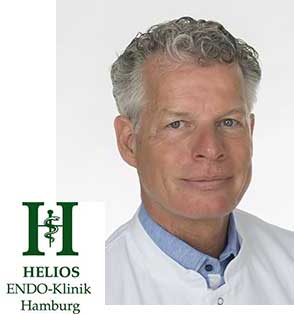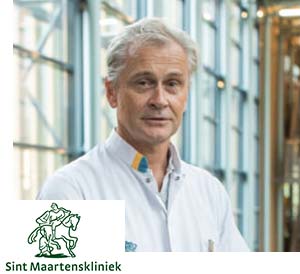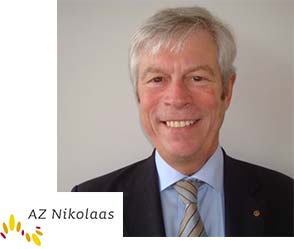Personalized acetabular implants designed to break the revision cycle.
Augment the predictability, trust the outcome.
Up to 27% of hip revisions are re-revisions due to a suboptimal fixation and suboptimal biomechanical reconstruction of the joint1 when combining standard components. What’s even worse, hip re-revisions are 3 times more likely to fail compared to a primary acetabular revision2. Fortunately, you can break this downward spiral. Meet Materialise aMace, the personalized one-piece solution with a 98% implant survival3 and 100% patient satisfaction rate4.
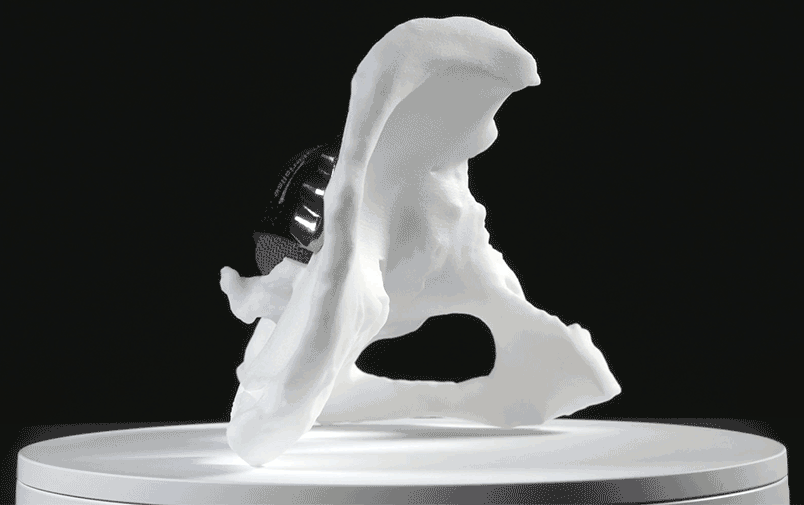
Why opt for a personalized hip revision?
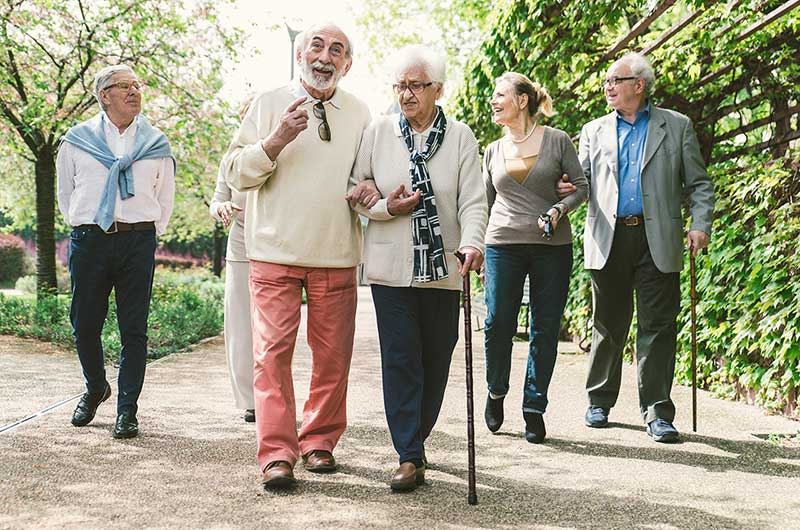
Trust a 98% implant survival
Rely on over 10 years of experience with personalized hip solutions and more than 700 complex arthroplasties. Based on published cases with an average follow-up of 2 years, you can trust on a 98% implant survival1. The aMace hip revision solutions are designed to optimize fixation and minimize the risk of dislocation by planning the position of the center of rotation, inclination and anteversion angles preoperatively. In addition to the one-piece trabecular augment, we enable you to achieve a more predictable outcome from the start through extensive preoperative planning and patient-specific drill guides. A total package that benefits both surgical teams and patients.
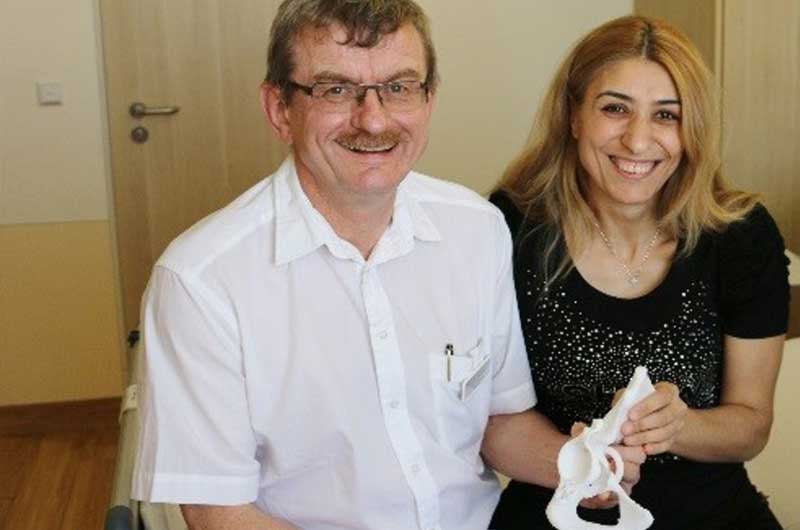
Rely on 100% patient satisfaction rate
The aMace hip revision solution works for both patient and surgeons. In addition to a 100% patient satisfaction rate4, up to 83% of queried patients report a tangible positive impact on their daily life in terms of mobility and pain after receiving a personalized aMace hip implant5. For one, this even meant finally getting out of a wheelchair again6. Moreover, the excellent service provided by our clinical engineers is reflected by a high surgeon satisfaction rate7. The overall majority of queried surgeons8 even stated that the aMace solution brought ease to even the most complex hip revision surgery.
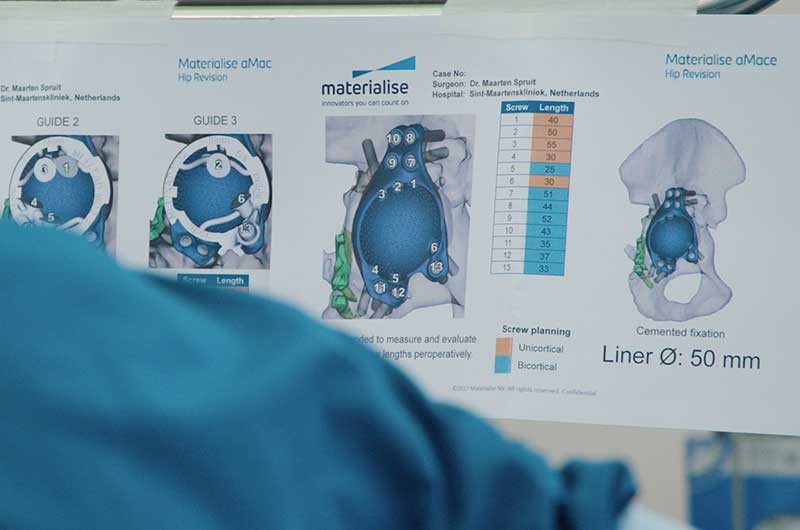
Feel confident about 3D planning your hip revision
Trust a team of highly-experienced clinical engineers to collaborate with from start to finish. We use your patient’s medical scans to design an accurate preoperative 3D plan, including a detailed outline of the procedure, as well as an overview of the screw positioning and lengths. Having such a patient-specific 3D-planned manual of the procedure enables you and your surgical team to enter the OR better prepared, reduce intraoperative decisions, and give the patient a better understanding of the procedure.
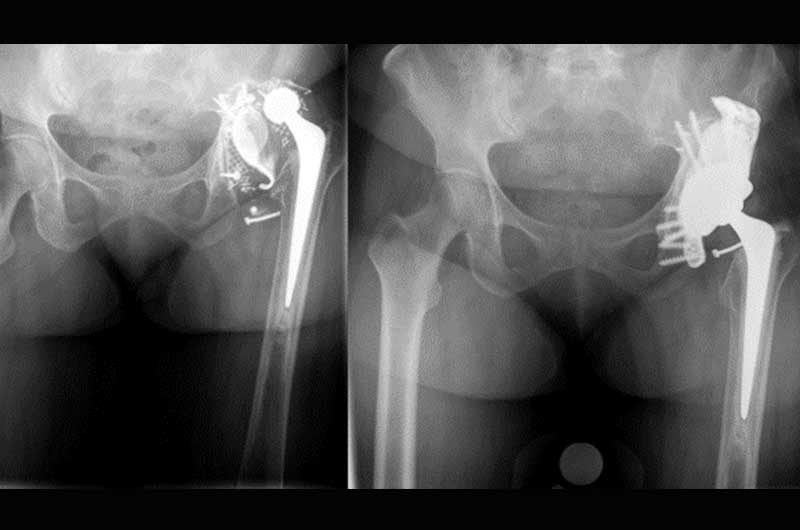
Optimize the long-term fixation and stability of hip implants
Using crossed screw trajectories based on the patient-specific bone visualization map, our defect-filling acetabular implant is designed to optimize primary and secondary fixation by maximizing implant-to-bone contact. Additionally, it aims to optimize the implant’s stability by planning the position of the center of rotation, inclination, and anteversion angles preoperatively. Extensive follow-up studies focusing on 74 cases report no signs of radiological loosening, while dislocation cases were all successfully resolved by closed reduction: none required a re-revision of the aMace augment9.
How we enable you to break the revision cycle
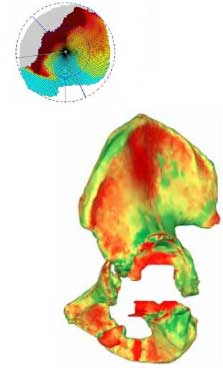
Unique 3D Visualization of Hip
The aMace solution starts with a detailed preoperative planning, including a unique patient-specific analysis of the hip. Based on the segmented CT scan, our highly-trained clinical engineers implement A.I.-enabled technology to quantify the radial acetabular bone loss and visualize the available bone stock by measuring the thickness of the bone and cortex over the entire surface.
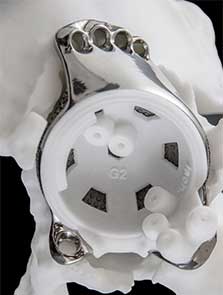
Patented drill guides
The 3D-printed drill guides have been designed to be easy to use, while giving you the confidence of executing the detailed screw planning. Its innovative guide design fits perfectly in the acetabular implant and allows you to optimize primary fixation by placing the required cross-fixated screws as indicated by the detailed preoperative plan. Based on the extensive experience gained through patient-specific hip and knee guides, we offer you a novel tool that adds ease to even the most complex acetabular procedures.
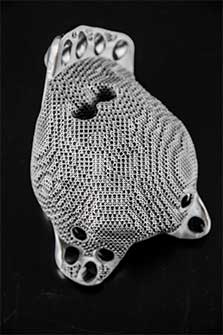
Trabecular biocompatible augment
Tap into the advantages offered by a defect-filling trabecular augment made of a highly biocompatible material: Ti6AI4V ELI (a titanium alloy). The back of the light-weighted integrated cup and flanges consist of a porous structure that mimics bone properties designed to improve secondary fixation through bone ongrowth and ingrowth. Moreover, a personalized design intends to maximize bone preservation and allows for the adaptation of the one-piece implant to the patient instead of the other way around.
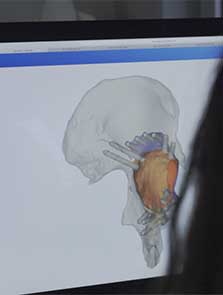
Easy-to-use digital platform to collaborate and order online
Materialise SurgiCase is a web-based 3D planning platform that enables clinical teams to upload, plan and collaborate with highly-qualified clinical engineers on cases in an easy-to-use and secure online location. Hospital staff can upload images securely knowing that our privacy regulations meet all the GDPR requirements. Whether you’re working at the hospital or from home using your computer or tablet: accessing the preoperative plan, giving feedback or approving the 3D design – SurgiCase makes it as easy as it gets.
get_app Download the digital brochure
What is the process?
-
CT SCAN
Upload the CT scan to the SurgiCase 3D planning platform. In order to help you achieve a predictable outcome, it is important that the scans meet the requirements stipulated by the Materialise Scan Protocol.
-
3D ANALYSIS
After visualizing the patient’s bone defects and present components in 3D, our clinical engineers map out the acetabular defect in terms of missing bone and thickness. Next, we perform an acetabular bone loss analysis so as to compare the patient’s situation with a healthy acetabulum.
-
3D PLAN AND DESIGN
Our clinical engineers design the actual implant based on the ideal center of rotation (COR) and bone preservation. We provide you with relevant measurements, a unique bone quality map and determine the ideal screw positioning. You review the design and provide your feedback through SurgiCase. While the overall majority of preoperative plans are approved from the start, we’re always there to discuss and adapt the implant design if needed.
1 WEEK
-
PRODUCTION
Once approved, the patient-specific implant design is produced in our medical-certified facilities. We also provide you with 3D-printed drill guides, an implant trial model and accurate bone model of the patient.
-
SHIPMENT
The complete package, including the case report, surgical technique, surgical poster and sterilization instructions, is shipped to your hospital – ready for surgery.
± 4 WEEKS
Example of a Personalized 3D-Printed Hip Arthroplasty
This video demonstrates how Dr. Van Hellemondt and Dr. Spruit (Sint-Maartenskliniek Nijmegen, The Netherlands) performed a total hip arthroplasty to reconstruct a large acetabular defect, more specifically a Paprosky 3B defect, by implementing the Materialise aMace hip solution.
Frequently asked questions
- General
- Getting started
- Technical
- Planning and Ordering platform
- Practical
-
For which patient and for which indications is this technology suitable?
We see that most patient cases are Paprosky IIIA and IIIB types, however, the advantageous Materialise acetabular system has been used in type II, dysplastic and tumor cases as well. It is intended for revision surgeries as well as primary surgeries. And naturally, as the implant is 3D printed and custom-made for each patient, it is not limited to severe cases. It can fit any defect. The medical indications can be summarized as follows:
done Non-inflammatory degenerative joint disease including osteoarthritis and avascular necrosisdone Posttraumatic and rheumatoid arthritisdone Correction of functional deformitydone Revision procedures where other treatments or devices have faileddone Treatment in conjunction with tumor resection where bone stock is of poor quality or is inadequate for other reconstructive techniques as indicated by deficiencies of the acetabulum -
Why choose a custom solution over a standard implant?
Although a standard solution may be the best one for a standard case, a patient-specific implant is often better suited for more challenging defects. With a Materialise aMace solution, you receive an implant which is pre-operatively designed to match the patient, and optimized for stability and biomechanical performance, resulting in a 98% implant survival. With the implant, you receive patient-specific drill guides, an extensive unique 3D analysis of the acetabular defect and planning for your surgery.
Compared to standard implants, whose multiple components need to be pieced intra-operatively, under stress and time pressure, thus jeopardizing the performance, our one-piece solution eliminates the entire process of selection and assembly, and the risks of intercomponent movements altogether.
In addition, Materialise aMace comes with an exclusive team of clinical engineers, always there for you to discuss the implant design and surgical planning. This gives you the assurance and confidence that the operation will be without surprises.
Contrary to standard implants where the cost can increase over time depending on the clinical outcome, the cost is calculated upfront. The transparency and high-tech value of the experience makes it a trustworthy technical and reliable solution. After having compared alternative solutions on the market, we've seen that preliminary data suggests that the aMace is a more cost-effective solution to treat complex acetabular defects.
Read more in this blog ‘putting a price tag on your 3D-Printed Hip’.
-
Is there evidence on patient-specific implants? Can I trust it?
Materialise has 10 years of experience in treating arthroplasty cases, 27 years of experience in the 3D software business and has already created more than 350,000 patient-specific guides and implants.
More than 700 patients worldwide were helped with this patient-specific hip implant so far. We currently have published evidence on 10% of our total experience. The results are very reassuring: the published follow-up data (mean follow-up of 2 years, which is the typical timeframe for early failures) result in 98% implant survival3 rate and 100% improved patient outcome4.
-
In which country is the product available?
Currently, Materialise aMace is sold directly in Australia and Europe (Austria, Belgium, Finland, France, Germany, Ireland, the Netherlands, Norway, Sweden and United Kingdom). In Poland, our solution is sold through a distributor. It is not yet commercially available in Canada and the US. -
What's the reimbursement process?
Reimbursement processes differ per country. They are dependent on legislation or on hospitals' contracts with insurance companies, DRG systems or special funds.
If you would like to know the specific reimbursement possibilities applicable to your country even before the planning phase, contact us and we will inform you right away.
-
What is the price?
The price differs according to each region, complexity and services needed. Contact your local sales representative in one of our offices or email to medical@materialise.be to receive more information.
-
If I have an interesting case, to whom should I reach out to ask for more information on the process and pricing?
You can contact your local sales representative in one of our offices or email to medical@materialise.be. Our team will make sure that your request is followed up.
-
Can I plan my own clinical cases in a hospital and ask Materialise to provide guides and/or implants?
No, we do not provide unique printing services as we consider the planning and design an integral part of the quality assurance of our products.
-
What are the advantages of a trabecular structure in an implant?
Osseointegration (the potential for bone in-growth) is the most important advantage, but there are more reasons to opt for a porous structure. The material properties of the porous structure better match the mechanical properties of the bone. The supporting trabecular augment is made of a highly biocompatible material: Ti6AI4V ELI (a titanium alloy). The back of the light-weighted integrated cup and flanges consist of a porous structure that mimics bone properties designed to improve secondary fixation through bone ongrowth. In addition, given the potential large size of the defect-filling implants, porous structures allow to reduce the total weight of the implant.
-
Is the implant sterile upon delivery?
The implant and accessories are always delivered non-sterile, so you can feel the parts upfront and prepare yourself better for surgery. Together with the package you will receive the sterilization instructions that clearly explain how the implant should be sterilized at the hospital. If you would want to look into them, contact your local sales representative in one of our offices or email to medical@materialise.be.
-
Do you provide screws with your implant?
No, we don’t. In the planning report, you will find the number of screws and screw lengths we recommend to use. The aMace solution is compatible with titanium spongiosa (6.5 mm diameter) screws with maximal head height 4.8 mm and head diameter between 7.6 and 8 mm. Based on the screw planning we provide, you’ll know well in advance how many and what sizes you will need, so the team is fully prepared before surgery. -
How do I access Materialise SurgiCase?
SurgiCase is a case management system that enables clinicians to totally streamline and simplify the planning and ordering of patient-specific guides and implants. The goal is to let you give your full attention to clinical treatment, and safely outsource all the technical aspects to experienced specialists at Materialise.
It is a web-based tool, accessible by our customers on account login. To get access to this platform, please fill in this contact form. Once your account is set, you can open a web browser on your device and go to https://surgicaseoos.materialise.com to login.
-
How do I upload my image data?
Image data is uploaded directly to the patient case via Materialise SurgiCase. Image upload can be done by a surgeon, radiology or other staff. Please refer to the SurgiCase User Guide for Image Upload in the “Help” menu in the SurgiCase platform for more information.
-
How long will it take to get my implant and accessories?
If your CT scans meet the requirements stipulated by the Materialise Scan Protocol Hip, we immediately start with the 3D analysis. You can expect to our 3D analysis, plan and implant design proposal within 5 working days from the upload of acceptable images. This process time depends on your availability to provide feedback on the surgical plan. After final approval of the implant design, production takes about 4 weeks.
-
Do the implant and accessories expire?
It is advised to use the guides, implant and models within 6 months of performing the CT scans on which they are based. If the patient’s anatomy has changed significantly since the time of the CT scan, the guides, models and implant should not be used, even if the time period of 6 months has not expired.
-
What is the difference between the planning report and the case report?
The Planning Report is an intermediate report that is used for discussion purposes. This report contains an implant proposal that can still differ from the final implant.
Before surgery the Case Report will be available in the Action Center of the case in our SurgiCase platform. This is the final report and contains all information on the case. The Case Report is to be used in preparation of and during surgery in combination with the surgical poster.
Contact us today if you too want to break the revision cycle.
At Materialise, we have been leveraging our experience for over 27 years to create a range of software solutions and 3D printing services that have become the backbone for the 3D planning and printing industry. The aforementioned products are not commercially available in the US and Canada. Please check our FAQ section for a full overview of countries where the aMace solution is commercially available.
Materialise fully acquired the company Mobelife (which introduced the aMace Acetabular Revision System) in 2015.
1 Swedish Arthroplasty Register, Annual Report 2014
2 Data UK Joint Registry
3 1/58 at mean follow-up time of 25 months, Baauw et al., 2017, 2015; Citak et al., 2017; Colen et al., 2013; Myncke et al., 2017; Goriainov et al. 2018
4 18/18, Baauw et al., 2017; Colen et al., 2013
5 From a Harris Hip Score of 22/100 pre-op to 59/100 2.5 y post-op – Citak et al., 2017.
6 Goriainov et al. 2018
7 81% (Myncke et al., 2017)
8 73% (16/22, Myncke et al., 2017)
9 N=74, 2 y post-op - Baauw et al., 2017, 2015; Citak et al., 2017; Colen et al., 2013; Myncke et al., 2017; Goriainov et al. 2018
This content is intended for Health Care Professionals only.



